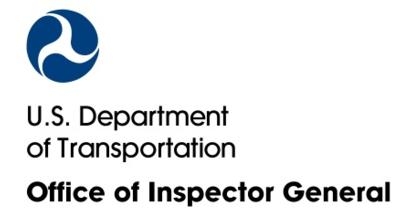Sun, Aug 20, 2017
Does not Include All Capabilities They Expect Will Produce Benefits
The DOT's Office of Inspector General has responded to a request from the leadership of the House Transportation Committee and its Aviation subcommittee concerning a review of the FAA's benefits projection in its July 2016 Next Generation Air Transportation System (NextGen) Business Case.

In its business case, FAA projected that NextGen will deliver about $161 billion in benefits by 2030, of which the Agency states that $2.7 billion has already been delivered to airspace users and the traveling public. At the Chairmen’s request, we provided information on the: (1) programs FAA included as NextGen programs and whether projected benefits represent a realistic assessment, (2) assumptions behind FAA’s benefits calculations, and (3) various groups FAA assumes will benefit and how the benefits are valued.
In the 18-page letter sent to Full Committee Chair Bill Shuster (R-PA) and Frank LoBiondo (R-NJ), Inspector General, Calvin Scovel III said that the office found that the FAA’s benefits estimate is overly optimistic given past experience with introducing new capabilities and the use of out-of-date schedules for some key projects.
The majority of FAA’s estimates are for new capabilities that have not yet been implemented, and some new capabilities continue to face challenges in delivering benefits to airspace users. In addition, while FAA recognizes that the key assumptions behind its benefits calculations are aggressive, the Agency does not provide alternative outcomes or adjust for risks that may impact the delivery of benefits to airspace users. Further, FAA relies heavily on valuing the time saved by passengers to make a positive business case for NextGen.
While this is a generally accepted practice, some airline representatives are concerned that reporting benefits in one, broad category makes it appear that airlines are receiving more substantial benefits than they actually have achieved.
FAA officials also noted that the business case does not include all capabilities that they expect will produce benefits but have yet to be quantified. As a result, FAA’s business case does not communicate the range of uncertainty or complex factors associated with NextGen implementation.
(Source: DOT OIG)
More News
He Attempted To Restart The Engine Three Times. On The Third Restart Attempt, He Noticed That Flames Were Coming Out From The Right Wing Near The Fuel Cap Analysis: The pilot repor>[...]
Make Sure You NEVER Miss A New Story From Aero-News Network Do you ever feel like you never see posts from a certain person or page on Facebook or Instagram? Here’s how you c>[...]
From 2009 (YouTube Edition): Leading Air Show Performers Give Their Best Advice for Newcomers On December 6th through December 9th, the Paris Las Vegas Hotel hosted over 1,500 air >[...]
Aero Linx: NASA ASRS ASRS captures confidential reports, analyzes the resulting aviation safety data, and disseminates vital information to the aviation community. The ASRS is an i>[...]
“For our inaugural Pylon Racing Seminar in Roswell, we were thrilled to certify 60 pilots across our six closed-course pylon race classes. Not only did this year’s PRS >[...]
 NTSB Final Report: Rutan Long-EZ
NTSB Final Report: Rutan Long-EZ ANN FAQ: Turn On Post Notifications
ANN FAQ: Turn On Post Notifications Classic Aero-TV: ICAS Perspectives - Advice for New Air Show Performers
Classic Aero-TV: ICAS Perspectives - Advice for New Air Show Performers ANN's Daily Aero-Linx (06.28.25)
ANN's Daily Aero-Linx (06.28.25) Aero-News: Quote of the Day (06.28.25)
Aero-News: Quote of the Day (06.28.25)



